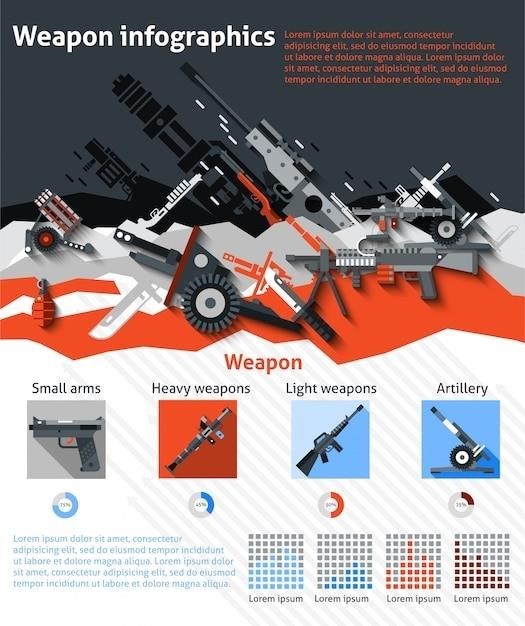GE Minigun Delinker⁚ A Comprehensive Guide
This guide explores the GE Minigun’s delinker mechanism, its crucial role in the firing cycle, and its evolution from the GAU-2B to the M134 and beyond. We’ll cover Dillon Aero’s contributions, modernization kits, maintenance, troubleshooting, and available manuals and resources for optimal delinker function.
The Evolution of the Minigun⁚ From GAU-2B to M134 and Beyond
The GE Minigun’s lineage traces back to the GAU-2B, an earlier iteration of the rotary machine gun. This model laid the groundwork for subsequent improvements and refinements. Dillon Aero, acquiring the rights, significantly advanced the design, resulting in the iconic M134. This model incorporated numerous enhancements, improving reliability and performance. The Marine Corps, facing budgetary constraints, cleverly utilized a hybrid approach, upgrading their older GAU-2Bs with parts from the more modern Dillon M134s, creating the GAU-17. This resourceful strategy extended the service life of existing weaponry. The evolution continued with Dillon Aero’s M134D, showcasing further advancements in technology and manufacturing. These improvements encompassed not only the core firing mechanism but also encompassed upgrades to the delinker system, reflecting ongoing efforts to optimize the weapon’s overall efficiency and reliability. The continuous refinement highlights the enduring relevance and adaptability of the Minigun design.
Understanding the Minigun’s Delinker Mechanism
The Minigun’s delinker is a critical component within the complex feeding system. Positioned at the base of the rotating barrel assembly, its primary function is the precise and rapid transfer of ammunition from the linked belt to the individual barrels. This intricate mechanism ensures each round is correctly positioned for chambering and firing. The delinker’s design involves a series of precisely engineered parts that work in synchronization with the rotating barrels. As the barrels spin, the delinker extracts rounds from the belt, stripping them from their links, and then precisely orients them for insertion into the chambers. The timing and accuracy of this process are paramount to the Minigun’s high rate of fire. Malfunctions in the delinker can lead to misfires, jams, or complete weapon failure. A thorough understanding of its operation, as detailed in technical manuals, is essential for maintenance and troubleshooting. Proper lubrication and maintenance are crucial for reliable operation. The Garwood feeder/delinker, a notable upgrade, features enhanced cartridge handoff and a high-performance coating for improved longevity and environmental resilience.
The Role of the Delinker in the Firing Cycle
The delinker plays a pivotal role in the rapid-fire sequence of the Minigun. Its precise timing is crucial for maintaining the weapon’s high rate of fire. The cycle begins with the linked ammunition belt feeding into the delinker mechanism. The delinker then extracts individual rounds, separating them from the links, and positions each round for insertion into a rotating barrel. This action is perfectly synchronized with the rotation of the barrel assembly. As a barrel rotates into the firing position, the delinker precisely presents a round to the bolt, which then chambers the round. Following ignition, the spent casing is ejected, and the cycle repeats seamlessly. The delinker’s efficiency directly impacts the weapon’s reliability and sustained firing capability. A malfunctioning delinker can cause stoppages, misfeeds, or even damage to other components. Understanding the precise mechanics of the delinker’s role within the firing cycle is crucial for effective maintenance and troubleshooting. Detailed diagrams and descriptions within technical manuals provide essential insights for those seeking to repair or maintain this vital component.
Dillon Aero’s Contributions to Minigun Technology

Dillon Aero, based in Scottsdale, Arizona, has significantly advanced Minigun technology, building upon the legacy of General Electric’s designs. Initially acquiring the rights to the GE Minigun, Dillon Aero became a leading manufacturer of complete Miniguns and upgrade components. Their contributions extend to enhanced reliability and improved performance through innovative design and manufacturing processes. They offer modernization kits that address shortcomings in older GE GAU-2B/M134 Miniguns, resolving issues such as poor reliability and parts scarcity. These kits often include upgraded feeder/delinker systems, clutch assemblies, and bolt assemblies, significantly extending the operational lifespan and effectiveness of these weapons. Dillon Aero’s expertise also encompasses the development of new Minigun variants, such as the M134D, incorporating advancements in materials, manufacturing techniques, and overall system design. The company’s commitment to continuous improvement ensures that Miniguns remain a relevant and effective weapon system in modern applications. Their contributions have established them as a key player in the continued evolution of this iconic weapon.
Minigun Modernization and Upgrade Kits
Modernization kits are crucial for extending the service life and improving the performance of older generation General Electric (GE) GAU-2B/M134 Miniguns. These kits address common issues such as poor reliability and parts shortages, bringing these weapons up to contemporary standards. A typical kit might include upgrades to several key components. The feeder/delinker system, responsible for smoothly feeding cartridges into the rotating barrels, is frequently upgraded for enhanced reliability and efficiency. Improvements to the clutch assembly ensure smoother operation and power transfer to the rotating barrel assembly. The bolt assemblies, crucial for chambering and firing the rounds, may be replaced with more durable and reliable components. Additionally, some kits incorporate improved materials and manufacturing techniques, resulting in increased longevity and performance. These upgrades not only restore functionality to older Miniguns but also often enhance their performance, making them comparable to newer models. The availability of these kits is a significant factor in maintaining the viability of the Minigun platform for various military and civilian applications. The use of such kits helps extend the service life of older weapons systems, reducing maintenance costs and improving operational readiness.
Maintenance and Repair of the GE Minigun Delinker
Proper maintenance is vital for ensuring the reliable operation of the GE Minigun delinker. Regular inspections should be conducted to identify and address potential issues before they escalate into major problems. The delinker mechanism, including its linkage, push rods, and associated components, should be carefully examined for wear, damage, or misalignment. Cleaning is essential to remove any accumulated debris or residue that might impede the smooth functioning of the mechanism. Lubrication with appropriate high-performance lubricants is crucial to reduce friction and wear, extending the life of the parts. Repair procedures vary depending on the specific issue. Simple repairs, such as replacing worn bushings or adjusting linkages, can often be performed in the field. More complex repairs, involving the replacement of damaged components, may require specialized tools and expertise. Detailed technical manuals provide comprehensive instructions for performing maintenance and repair procedures. These manuals often include exploded diagrams, part lists, and step-by-step instructions, making it easier for technicians to diagnose and resolve various delinker-related issues. Adherence to these guidelines ensures correct procedures and avoids potential damage to the system.
Troubleshooting Common Delinker Issues
Troubleshooting a malfunctioning GE Minigun delinker often begins with a visual inspection. Look for obvious signs of damage, such as bent or broken components, excessive wear, or misalignment. Check for proper lubrication; insufficient lubrication can lead to increased friction and malfunction. If the delinker fails to feed rounds consistently, inspect the linkage and push rods for binding or obstruction. Foreign objects lodged in the mechanism can interfere with its operation. Carefully examine the cartridge path for any obstructions. A common issue is the failure of the delinker to properly disengage spent cartridges. This can result from worn components or incorrect timing. Consult the technical manual for detailed specifications and timing diagrams to ensure proper adjustment. If the problem persists after these checks, further investigation may be necessary. This could involve using specialized tools to measure clearances, check for wear patterns, or test the functionality of individual components. Remember, improperly functioning delinkers can lead to misfires or jams, compromising the weapon’s reliability and safety. Always refer to the manufacturer’s documentation and consult qualified technicians for complex issues.
Sources for Minigun Parts and Manuals
Locating parts and manuals for the GE Minigun, especially for older models like the GAU-2B, can require some effort. Dillon Aero, having acquired the rights to the design and producing the M134, is a primary source for both modern parts and upgrade kits. Their website and contact information should be your first stop. Online marketplaces, such as GunBroker, may offer used or surplus parts, but exercise caution and verify authenticity. Be mindful of the potential for counterfeit or substandard components. Specialized military surplus dealers often carry a range of parts, though availability fluctuates. Networking with other Minigun owners and enthusiasts through online forums can provide invaluable leads on less common parts and sources. For technical manuals, searching online databases and auction sites may yield results, but be aware that these often come at a premium price. The quality and completeness of these manuals should be carefully assessed before purchase. Consider contacting military museums or archives; they may have access to original documentation or be able to point you towards other relevant sources. Always ensure any acquired manuals match your specific Minigun model for accurate maintenance and repair information.
The Garwood Feeder/Delinker Upgrade
The Garwood feeder/delinker represents a significant enhancement to the standard GE Minigun feeding system. This upgrade focuses on improving the cartridge handoff process, a critical aspect of the weapon’s reliability and sustained rate of fire. The Garwood system boasts an improved design for smoother and more consistent feeding, reducing the likelihood of malfunctions caused by jamming or misaligned cartridges. A key feature of the Garwood upgrade is its enhanced durability. The implementation of a new, high-performance coating protects the system against wear and corrosion, ensuring optimal performance in diverse environmental conditions. This extended lifespan translates to reduced maintenance needs and fewer costly replacements. While specific details of the internal mechanisms may vary depending on the model and year of manufacture, the core principle remains consistent⁚ a more robust and efficient method of transferring cartridges from the feed belt to the rotating barrels. This upgrade is highly valued by users who demand reliable performance and minimal downtime, especially in demanding operational environments. The improved coating also enhances resistance to extreme temperatures and humidity, contributing to the overall reliability and longevity of the weapon system.
Available Technical Manuals and Resources
Securing comprehensive technical manuals for the GE Minigun and its delinker system is crucial for proper maintenance and repair. While official documentation may be restricted, various sources offer valuable information. One example cited includes a technical manual from October 2005, encompassing over 500 pages across two spiral-bound volumes. This extensive resource provides detailed diagrams, specifications, and step-by-step instructions covering both Dillon and GE Miniguns. It’s a valuable asset for understanding the intricacies of the delinker and related components, offering guidance on maintenance, repair, and the identification of replacement parts. Beyond formal manuals, online forums and communities dedicated to firearms and weaponry often provide valuable insights and troubleshooting tips from experienced users and technicians. These forums can be invaluable resources for locating hard-to-find parts or manuals, and for obtaining alternative perspectives on maintenance procedures. Remember that accessing and utilizing such information responsibly and legally is paramount. Always adhere to relevant regulations and safety guidelines when handling firearms and their components.

The Importance of Proper Delinker Function
The GE Minigun delinker’s role is paramount to the weapon’s reliable operation. Its smooth and consistent function ensures uninterrupted feeding of ammunition into the rotating barrels, directly impacting the weapon’s rate of fire and overall effectiveness. Malfunctions in the delinker mechanism can lead to immediate stoppages, potentially compromising the weapon’s ability to perform under pressure. Regular maintenance, as outlined in appropriate technical manuals, is essential for preventing such issues and maintaining peak performance. The longevity and reliability of the delinker are also significantly impacted by the quality of maintenance and the use of appropriate parts. Upgrading to improved delinker systems, such as the Garwood feeder/delinker, can enhance performance, extending the weapon’s lifespan and improving its operation in diverse environments. Understanding the delinker’s operation, as detailed in resources like the extensive 2005 technical manual, is crucial for both military and civilian users, ensuring safe and effective utilization of this powerful weapon system. Proactive maintenance directly translates to enhanced reliability and operational readiness.